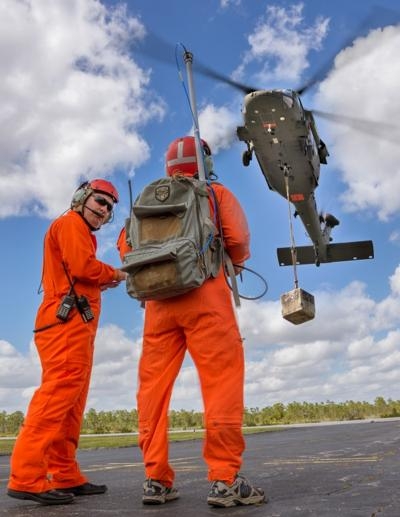Wed, Apr 23, 2014
Showed Autonomous Hover And Flight Operations For U.S. Army
In cooperation with the U.S. Army, Sikorsky has successfully demonstrated optionally piloted flight of a Black Hawk helicopter, a significant step toward providing autonomous cargo delivery functionality to the U.S. Army.

The Optionally Piloted Black Hawk (OPBH) Demonstrator, known as Sikorsky’s Manned/Unmanned Resupply Aerial Lifter (MURAL) Program, conducted the successful first flight demonstration on March 11 at Sikorsky’s Development Flight Center. The demonstration was conducted through the use of Sikorsky’s Matrix Technologies and advanced Ground Control Station (GCS) Technologies.
The OPBH demonstrated autonomous hover and flight operations while under the control of a man-portable GCS, demonstrating the capability for expeditionary operations and critical cargo resupply. “The autonomous Black Hawk helicopter provides the commander with the flexibility to determine crewed or un-crewed operations, increasing sorties while maintaining crew rest requirements. This allows the crew to focus on the more ‘sensitive’ operations, and leaves the critical resupply missions for autonomous operations without increasing fleet size or mix,” said Mark Miller, Sikorsky Vice President of Research & Engineering.
The MURAL Program is a cooperative effort between the U.S. Army Aviation Development Directorate (ADD), the U.S. Army Utility Helicopters Project Office (UH PO) and Sikorsky. The UH PO is providing access to two UH-60MU Black Hawk helicopters and Sikorsky is applying the technology it has developed with Internal Research and Development funding.
Sikorsky has been developing the technology since 2007, and signed a Cooperative Research & Development Agreement (CRADA) with the U.S. Army in 2013 to advance the program to a formal effort to demonstrate the full flexibility and value of a full authority flight control system. The effort includes demonstration of expeditionary ground control systems and precision control. “The ADD’s mission is to focus on developing, demonstrating and applying critical technologies that enhance the capability, affordability, readiness and safety of Department of Defense aviation systems,” said Dr. William Lewis, Director, ADD. “The optionally piloted Black Hawk helicopter functionality stands to bring added value to DoD aviation systems, through the innovations being tested on the Black Hawk helicopter in the MURAL program.”
According to COL Thomas Todd, the Utility Helicopters Project Manager, “MURAL technology will advance material solutions related to Degraded Visual Environment operations. These solutions will provide critical flight control and flight handling quality improvements.”
Sikorsky introduced its Matrix Technology, a major research program, in July 2013 to develop, test and field systems and software that will improve significantly the capability, reliability and safety of flight for autonomous, optionally piloted, and piloted vertical take-off and landing (VTOL) aircraft. The Sikorsky Autonomy Research Aircraft (SARA) flew its first flight on July 26, 2013 and continues to explore new functionality in that portion of the program.
The application of Matrix Technology to the OPBH is an initial step toward demonstrating the flexibility, adaptability and capability to a range of aircraft systems. “Applying Matrix Technology to an already robust, reliable, and safe platform leverages these capabilities while expanding the system’s effectiveness,” Miller added.
Matrix aims to give rotary and fixed wing VTOL aircraft a high level of system intelligence needed to complete complex missions with minimal human oversight and at low altitudes where obstacles abound.
(Image provided by Sikorsky)
More News
Also: B-29 Superfortress Reunion, FAA Wants Controllers, Spirit Airlines Pulls Back, Gogo Galileo Van's Aircraft posted a short video recapping the goings-on around their reorganiz>[...]
Light Gun A handheld directional light signaling device which emits a brilliant narrow beam of white, green, or red light as selected by the tower controller. The color and type of>[...]
"The journey to this achievement started nearly a decade ago when a freshly commissioned Gentry, driven by a fascination with new technologies and a desire to contribute significan>[...]
"Our driven and innovative team of military and civilian Airmen delivers combat power daily, ensuring our nation is ready today and tomorrow." Source: General Duke Richardson, AFMC>[...]
Aircraft Conflict Predicted conflict, within EDST of two aircraft, or between aircraft and airspace. A Red alert is used for conflicts when the predicted minimum separation is 5 na>[...]
 Airborne 04.16.24: RV Update, Affordable Flying Expo, Diamond Lil
Airborne 04.16.24: RV Update, Affordable Flying Expo, Diamond Lil ANN's Daily Aero-Term (04.20.24): Light Gun
ANN's Daily Aero-Term (04.20.24): Light Gun Aero-News: Quote of the Day (04.20.24)
Aero-News: Quote of the Day (04.20.24) Aero-News: Quote of the Day (04.21.24)
Aero-News: Quote of the Day (04.21.24) ANN's Daily Aero-Term (04.21.24): Aircraft Conflict
ANN's Daily Aero-Term (04.21.24): Aircraft Conflict



